 |
The Saint of the Day
Pope St. Peter Celestine – May 19
Prof. Plinio Corrêa de Oliveira
Biographical selection:
This was a saint remarkable for running from glory during his life. He is called the Phoenix of the Church, and was truly unique in his role: a solitary religious suddenly placed on the Throne of St. Peter who spontaneously abdicated from that glorious situation even though none disputed his position.
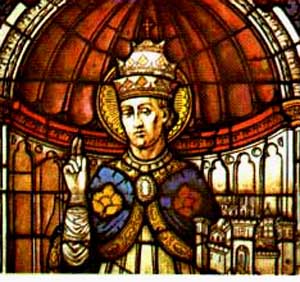
Stain glass window of St. Peter Celestine in Santa Maria di Collemaggio Church, below, which he built in Apulia, Italy, at the request of Our Lady
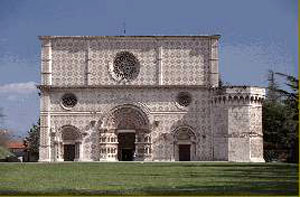 |
Miracles illustrated his life, simplicity illustrated his soul. He was born in the Abruzzi, Italy, the eleventh of twelve children of peasant parents. Seeing his inclination to piety, his mother saw to it that he received a good literary education.
In his daily prayers Peter used to receive the visit of Angels, Saints and the Virgin Mary. He recounted everything with simplicity to his mother. Later, he became a hermit and the fame of his sanctity spread.
He built a church, Santa Maria di Collemaggio, in Aquila, whose consecration was made by the Angels. He founded a monastery on the top of Mount Morrone, and later these monks would become known as Celestines. However, fleeing glory, he did not remain there, but after it was established, retired to a more solitary place.
In 1274, Peter went to Rome to defend his foundation that had been threatened. With the help of a miracle, he received the approbation of Pope Gregory X for his religious Order. As he prepared to say Mass before the Pontiff, he had the desire to have his dignified, but poor and simple vestments that he had left behind. Immediately Angels appeared and delivered them into his hands. After receiving the approbation, he retuned to his solitude.
Upon the death of Nicholas IV, the see of Rome remained vacant two years and three months. Finally, on an inspiration, the Cardinals assembled at Perugia proposed Peter’s name, and he was unanimously elected.
Alarmed at hearing this news, Peter betook himself to flight in the company of one of his monks, but was intercepted. He returned to Mount Morrone, where the Kings of Hungary and Naples came to implore him to accept the Papacy for the good of the Church. Peter agreed. This hermit who had hesitated to say the Holy Mass was elevated to the Supreme Priesthood on August 29, 1294.
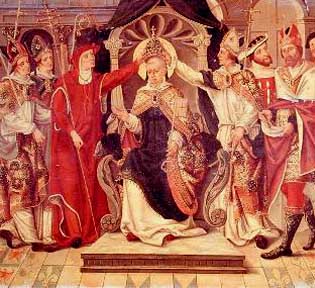
The coronation of Pope Celestine V in August 1294
French School, 16th century, Le Louvre, Paris |
When he was still a young man, he had considered himself unworthy of celebrating Mass, and he only changed his mind after hearing a Divine Voice that convinced him. “I am not worthy of offering the Holy Sacrifice,” he protested. The Voice replied: “And who is worthy of such a thing? Celebrate it, despite your unworthiness, but offer it in fear.”
In the Pontifical See, Peter conformed himself to the will of God, but could not stop thinking that this was not his vocation. He continued his former austerities and lived in solitude among the crowds that surrounded him. Finally, he decided to abdicate. When his decision became public, many vigorously opposed the motion, but no solicitations or motives could change his resolution. Therefore, on December 13, 1294 clothed in full pontifical vesture, he read before the Cardinals this act of his great renunciation:
“Inspired by many legitimate reasons, desiring a more humble state and a more perfect life, fearing to compromise my conscience and seeing my weakness and incapacity, considering the malice of men and yearning for the rest and spiritual consolation I enjoyed before I was raised to this position, I, Celestine V, Pope, do hereby freely and voluntarily renounce the Sovereign Pontificate and abandon the dignity and position to which I was raised.”
And then Peter returned to his solitude to die.
Comments of Prof. Plinio:
The first fact that strikes our attention when we hear this report is the innocence of St. Peter Celestine’s life when he was a boy. He had constant contact with the Angels and reported every single thing to his mother, who would also accept it naturally.
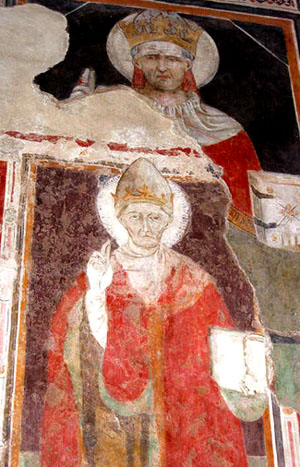
A recently discovered fresco of St. Celestine
|
We can imagine the scene, a simple peasant woman, cleaning the house, washing the family’s clothes or kneading dough to make bread, listening to the narration of the boy about his relations with the Angels. It is a charming dialogue of the innocence of childhood with the benevolence of motherhood.
Second, it is also interesting to notice how the solitary and saintly life of a hermit attracted the masses. Many persons sought out Peter to ask counsel and orientation in their lives. He was a man who turned his back on the values of the world, showing that they were worth nothing to him, and retired to a solitary place to speak only with God. This caused a frisson of admiration in the multitudes that went to visit him, ask his advice and pray for him. St. Peter did not need to wear the clothing of the layman or go to night clubs to attract people, as monks and priests have done since Vatican II. He did the opposite. He abandoned everything, which from a pagan perspective seems madness, and was rewarded by the grace of God and attracted large crowds.
Third, he built a church and when he had completed it, the Angels were so pleased that they came themselves to consecrate it. No human hand was necessary, but Angels made the consecration of his church. This shows how blessed the work of those solitary hermits habitually was.
In Rio, there was a hermit who lived on top of the Hill of Glory [Outeiro da Glória], called this because he build a small chapel to Our Lady of Glory there. He also lived alone in that magnificent place. It was a site of grace and peace with a sole hermit praying to Our Lady, irradiating a supernatural ambience over the whole small Rio de Janeiro of times past. When we see priests and religious men today coming and going on motorcycles and we compare them to the life of that simple hermit, it grates on our souls.
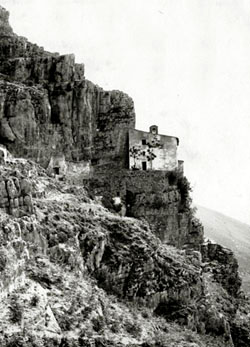
St. Peter's hermitage on Mount Morrone
|
Fourth, the scene of St. Peter preparing to say Mass for the Pope is also impressive. He had probably been provided with beautiful vestments to wear. But to the general surprise of those assisting at his Mass, he appeared clothed in his very simple vestments. He said his Mass, and at the end, the Pontiff may have commented: “So, Friar Peter, you preferred to wear your simple vestments. I didn’t know that you brought them with you.” His answer: “Your Holiness is correct. I did not have them, but the Angels brought them to me.” The Pope, amazed, remarked: “Oh, I see…” No wonder his fame for holiness was widespread, and that the Cardinals chose him to be Pope.
Fifth, the scene of the Kings of Hungary and Naples insisting that he accept the Papacy is also interesting. In his relation with those Kings, St. Peter Celestine had the simplicity of a man who did not need anything from them. Different from an opportunist who would be thinking of the advantages he could obtain, St. Peter had nothing to ask of them. Certainly he respected them very much, but the mention of the name of a King or Queen directed his thoughts first to the King and the Queen of Heaven, not toward any earthly interest.
Sixth, I imagine that on that first evening after his abdication from the Papacy, after the last committee of ecclesiastics and nobles had left him and the last clatter of horse hooves faded away in the distance, he re-commenced his solitary dialogue with God, a dialogue that would last until his death. It was for him the prelude to Heaven.


  | | Prof. Plinio Corrêa de Oliveira | |
The Saint of the Day features highlights from the lives of saints based on comments made by the late Prof. Plinio Corrêa de Oliveira. Following the example of St. John Bosco who used to make similar talks for the boys of his College, each evening it was Prof. Plinio’s custom to make a short commentary on the lives of the next day’s saint in a meeting for youth in order to encourage them in the practice of virtue and love for the Catholic Church. TIA thought that its readers could profit from these valuable commentaries.
The texts of both the biographical data and the comments come from personal notes taken by Atila S. Guimarães from 1964 to 1995. Given the fact that the source is a personal notebook, it is possible that at times the biographic notes transcribed here will not rigorously follow the original text read by Prof. Plinio. The commentaries have also been adapted and translated for TIA’s site.
|
Saint of the Day | Home | Books | CDs | Search | Contact Us | Donate

© 2002- Tradition in Action, Inc. All Rights Reserved
|
 |

|